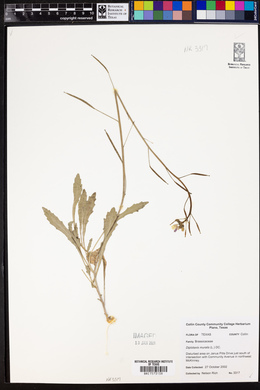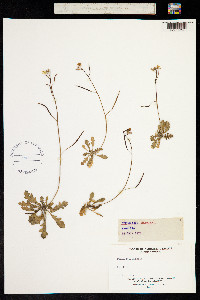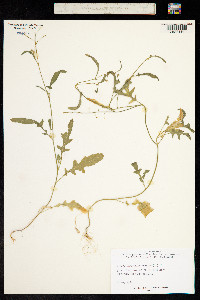Diplotaxis muralis
|
|
|
|
Family: Brassicaceae
Annual Wallrocket
[Sisymbrium murale L.] |
Annuals or perennials, (short-lived, frequently scapose or subscapose, taprooted), strongly scented (with glucosinolates). Stems ascending to suberect, (0.5-)2-5(-6) dm, moderately pubescent (trichomes predominantly patent basally, retrorse distally to near racemes). Basal leaves (rosulate); blade elliptic to obovate, 2-9 cm × 10-35 mm, margins sinuate to pinnatifid, lyrate, [2-4(-6) lobes each side], (margins and veins glabrescent to sparsely pubescent). Cauline leaves shortly petiolate to sessile; blade margins entire or dentate. Fruiting pedicels (3-) 8-20(-37) mm. Flowers: sepals 3-5.5 mm, pubescent or glabrous, trichomes straight; petals yellow, 5-8(-10) × 3-5 mm; filaments 3.5-6 mm; anthers 1.5-2 mm; gynophore obsolete or to 0.5 mm. Fruits erect-patent, (1.5-)2-4 cm × 1.5-2.5 mm; terminal segment beaklike, (1-)1.5-3 mm, seedless; (ovules 20-36 per ovary). Seeds 0.9-1.3 × 0.6-0.9 mm. 2n = 42. Flowering spring-fall. Waste ground, disturbed or cultivated soil, ballast places, wharves, roadsides, railroads, around buildings, grazed grasslands; 80-2000 m; introduced; Alta., N.B., N.S., Ont., P.E.I., Que., Sask.; Ala., Ariz., Ark., Calif., Conn., Fla., Ill., Ind., Iowa, Kans., Mass., Mich., Minn., Mont., Nebr., N.J., N.Mex., N.Y., Ohio, Oreg., Pa., Tex., Utah, Wis.; Eurasia; Africa; introduced also in Mexico (Coahuila, Nuevo León), West Indies (Bahamas), Bermuda, South America, Pacific Islands (New Zealand), Australia. Diplotaxis muralis was introduced from Europe as a ballast plant in the last century and may have failed to persist in some of the recorded provinces and states. It is an allopolyploid arisen from D. tenuifolia and the Eurasian D. viminea (Linnaeus) de Candolle with 2n = 20 (M. D. Sánchez-Yélamo and J. B. Martínez-Laborde 1991; K. Mummenhoff et al. 1993; G. Eschmann-Grupe et al. 2003). There does not seem to be a sound basis for attributing D. viminea to the flora area, as done by V. I. Dorofeev (1998), because most specimens cited by him belong, in fact, to D. muralis.
Annual or perennial herb 20 cm - 0.5 m tall Stem: upright or sprawling, branched basally, sometimes sparsely hairy. Leaves: mainly at or near base, coarsely toothed or sometimes pinnately divided, reverse lance-shaped, bases long-tapering. Flowers: yellow. Sepals four, upright or ascending, 2.5 - 5 mm long. Petals four, 4 - 7 mm long, bases narrowed. Stamens six. Fruit: a long, narrow pod, not on a stipe (a type of supporting stalk), ascending, 2 - 4 cm long, 2 mm wide, each of the two sides with a prominent midvein. Seeds in two rows in each chamber. Similar species: Diplotaxis tenuifolia is similar but has leaves above the base, shorter sepals (5 - 8 mm), and fruit which is on a stipe. Flowering: May to late October Habitat and ecology: Introduced from Europe. A weed typically found on lawns, roadsides, and along railroads. Also found in sandy disturbed ground, especially along the shore of Lake Michigan. Occurence in the Chicago region: non-native Etymology: Diplotaxis comes from the Greek word diploos, meaning double, and taxis, meaning row, which refers to the double row of seeds in the pod. Muralis means "slender leaves." Author: The Morton Arboretum Glabrous or sparsely hairy annual (to perennial), erect or decumbent, 2-5 dm, branched from base; lvs chiefly at or near the base, oblanceolate, long-attenuate below, toothed to sometimes pinnatifid; lower pedicels becoming remote and 1-1.5 cm; pet yellow; frs ascending, 2-4 cm נ2 mm, not stipitate; 2n=42. Native of Europe, naturalized in waste places, especially in sandy soil, in much of the n. part of our range and westward. May-Sept. Gleason, Henry A. & Cronquist, Arthur J. 1991. Manual of vascular plants of northeastern United States and adjacent Canada. lxxv + 910 pp. ©The New York Botanical Garden. All rights reserved. Used by permission. From Flora of Indiana (1940) by Charles C. Deam Indiana Coefficient of Conservatism: C = null, non-native Wetland Indicator Status: N/A |


















































































